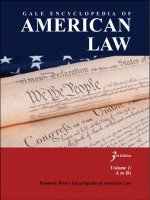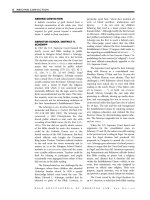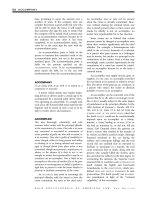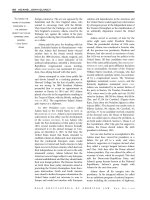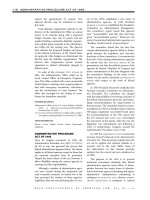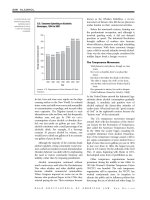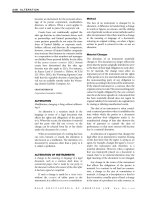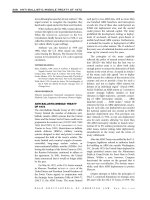Gale Encyclopedia Of American Law 3Rd Edition Volume 5 P3 pps
Bạn đang xem bản rút gọn của tài liệu. Xem và tải ngay bản đầy đủ của tài liệu tại đây (335.52 KB, 10 trang )
case. Fries chose to proceed to trial witho ut
benefit of LEGAL REPRESENTATION. He was again
found guilty and sentenced to death by hanging.
However, after studying the case, President
Adams pardoned him and the other insurgents.
Soon after his pardon, Fries was promoted
from captain to lieutenant colonel in the
Montgomery County, Pennsylvania, militia.
Justice Chase’s conduct in Fries’s second
trial was harshly criticized as indirectly depriv-
ing Fries of counsel. The justice’s actions were
used against him in 1805, in an unsuccessful
IMPEACHMENT proceeding.
FURTHER READINGS
Adams, Charles. 1998. Those Dirty Rotten Taxes: The Tax
Revolts That Built America. New York: Free Press.
Elsmere, Jane Shaffer. 1979. “The Trials of John Fries.”
Pennsylvania Magazine of History and Biography 103
(October).
Presser, Stephen. 1978. “A Tale of Two Judges ”
Northwestern Univ. Law Review 73 (March/April).
CROSS REFERENCE
Whiskey Rebellion.
FRISK
A term used in criminal law to refer to the
superficial running of the hands over the body of
an individual by a law enforcement agent or official
in order to determine whether such individual is
holding an illegal object, such as a weapon or
narcotics. A frisk is distinguishable from a search,
which is a more extensive examination of an
individual.
CROSS REFERENCE
Stop and Frisk.
FRIVOLOUS
Of minimal importance; legally worthless.
A
FRIVOLOUS suit is one without any legal
merit. In some cases, such an action might be
brought in
BAD FAITH for the purpose of
harrassing the
DEFENDANT. In such a case, the
individual bringing the frivolous suit might be
liable for
DAMAGES for MALICIOUS PROSECUTION.
A frivolous appeal is one that is completely
lacking merit, since no reviewable question has
been raised therein.
FROLIC
Activities performed by an employee during
working hours that are not considered to be in
the course of his or her employment, because they
are for the employee ’s personal purposes only.
The doctrine of
RESPONDEAT SUPERIOR makes a
principal liable for the torts of his or her agent
occurring during the
COURSE OF EMPLOYMENT.
This is based on the concept that a principal has
control over his or her agent’s behavior. If an
agent was hired to drive from point A to point
B, and, throu gh reckless driving, hit a pedestri-
an along the way, the principal would ordinarily
be held liable. If, however, the agent was
engaged in
FROLIC, the principal would not be
liable. This might occur, for example, if an
employee were hired to transport goods from
point A to poi nt B and made severa l detours
along the way for personal reasons. If the
employee became involved in an accident while
on a frolic, the employer would not be liable
unless it could be established that he or she was
negligent in the hiring or supervision of the
employee.
FRONTIERO V. RICHARDSON
The fight to end gender DISCRIMINATION in the
U.S. began in the nineteenth century with the
women’s
SUFFRAGE movement and the enact-
ment of laws that protected the property that
women brought into marriages. By the 1960s
the focus had shifted to ending pay and benefit
discrimination based on gender. By the early
1970s, Congress had passed the
EQUAL RIGHTS
AMENDMENT
(ERA) of the U.S. Constitut ion,
which proclaimed equality between the genders.
RATIFICATION appeared close by 1973, as 38 states
had ratified the ERA. The court system also
became an arena for the issue of gender
discrimination. The U.S. Supreme Court began
to consider cases of gender discrimination but
hesitated to place gender in the same category as
race or ethnicity as a
SUSPECT CLASSIFICATION
inviting the most rigorous CONSTITUTIONAL
review. However, a plurality of the court
endorsed gender as a suspect classification in
Frontiero v. Richardson, 411 U.S. 677, 93 S. Ct.
1764, 36 L. Ed.2d 583 (1973). This important
case pushed the Court, and society in general, to
recognize the legal disabilities that women had
lived with for centuries. Though not a
LANDMARK
decision, Frontiero signaled the willingness of
the high court to take gender issues seriously.
The facts of the case illustrated the disparate
treatment built into U.S. society concerning
the role of women. Sharron Frontiero was a
GALE ENCYCLOPEDIA OF AMERICAN LAW, 3RD E DITION
8FRISK
U.S. Air Force officer who was married to
Joseph Frontiero, a full-time studen t at a college
near the Alabama base where Sharron was
stationed. Congress had passed a law that
provided fringe benefits to members of the
armed forces in the hopes that they would re-
enlist and pursue a military career. Under this
law, a member of the armed forces with
dependents was entitled to an increased housing
allowance and comprehensive dependent medi-
cal and dental care. However, the law made a
distinction between male and female members.
A serviceman could claim his wife as a
dependent simply by certifying that they were
married. A servicewomen such as Frontiero,
however, could not claim her husband as a
dependent unless she proved that he was
dependent upon her for more than one-half of
his support. Joseph Frontiero’s living expenses
totaled $354 per month, but he received $250
per month in veteran’s benefits. Therefore, he
was not dependent on his wife for more than
one-half of his support. Based on these calcula-
tions, the Air Force denied Sharron Fronteiro
the additional benefits.
Frontiero sued the Air Force, alleging that
the difference in treatment was unconstitutional
discrimination under the Fifth Amendment’s
Due Process Clause. A three-judge panel from
the U.S. Court for the Middle District of
Alabama rejected this claim, with one judge
dissenting. Frontiero, with the help of the
AMERICAN CIVIL LIBERTIES UNION (ACLU) and its
ATTORNEY, RUTH BADER GINSBURG , took the case to
the U.S. Supreme Court.
The Court, in an 8–1 decision, overturned the
lower
RULING and held that the salary supplement
law violated the Due Process Clause. However,
the justices could not agree on the constitutional
standard of review that should be applied to
allegations of gender discrimination. In a plurali-
ty opinion for four justices, Justice William
Brennan concluded that gender, like race, was a
suspect classification. The suspect classification
standard holds that laws which classify people
according to race, ethnicity, or
RELIGION are
inherently suspect and that they are subject to
the
STRICT SCRUTINY test of JUDICIAL REVIEW. Strict
scrutiny requires the state to provide a compelling
interest for the challenged law and to demon-
strate that the law has been narrowly tailored to
achieve its purpose. If a suspect classification is
not involved, the Court will apply the
RATIONAL
BASIS TEST
, which requires the state to provide any
type of reasonable ground for the legislation.
Under strict scrutiny, the government has a
difficult burden to meet, while under the rational
basis test, most laws will be upheld.
In 1971, the Court, in Reed v. Reed, 404 U.S.
71, 92 S. Ct. 251, 30 L. Ed.2d 225, extended the
application of the
EQUAL PROTECTION clause of the
FOURTEENTH AMENDMENT to gender-based dis-
crimination. However, the Court had used the
rational basis test. Nevertheless, Justice Brennan
argued that Reed
IMPLIED that gender was a
suspect classification and that strict scrutiny
should apply. There were four reasons in his
view for making gender a suspect class. First,
gender was, like race, an “immutable” accident
of birth that was
IRRELEVANT to the purpose of
the
FEDERAL law. Second, Brennan pointed to the
long history in the U.S. of discrimination based
on gender. He noted that statute books had
been filled with “gross, stereotyped distinctions
between the sexes.” Although women had seen
their lot improve in modern America, they still
faced “pervasive, although at times more subtle,
discrimination in our educational institutions,
in the job market and, perhaps most conspicu-
ously, in the political arena.” In addition, gender,
like race, was a highly visible trait. Finally,
Brennan acknowledged the ERA, which made
clear that gender classifications were “inherently
invidious.”
Based on these factors, Brennan had no
trouble ruling the law unconstitutional. The
government could not show a compelling
interest for the benefit discrimination. It
claimed that administrative efficiency justified
the law, as most members of the armed forces
were men. It would have cost more to process
applications required from Frontiero and the
small percentage of women in uniform. This
was not a compelling interest for Brennan and
the plurality.
Justice
LEWIS POWELL, in a concurring opinion
joined by Chief Justice
WARREN BURGER and Justice
HARRY BLACKMUN, agreed that the law was uncon-
stitutional. Powell disagreed with the plurality’s
conclusion that strict scrutiny was warranted. He
contended that the Court should not make that
conclusion while the ratification of the ERA was
pending. By declaring gender a suspect clarifica-
tion, the judicial branch would, in effect, trump
the ERA. In his view, it was better to allow the
states to determine whether gender should be
GALE ENCYCLOPEDIA OF AMERICAN LAW, 3RD E DITION
FRONTIERO V. RICHARDSON 9
regarded as a suspect class. The seven-year
ratification period had run for just one year, so
the Court should refrain from ruling. Powell
concluded that the rational basis test applied in
Reed worked in this case as well. The government
did not have a reasonable justification for unequal
treatment of service members.
Justice
WILLIAM REHNQUIST dissented, citing
the reasoning of the lower court to show that
the administrative savings from not requiring
men to justify dependent benefit eligibility
provided a rational basis for the law.
By failing to gain a majority, the court did
not
ESTABLISH gender as a suspect classification
requiring strict scrutiny. By the end of the
decade, the ERA was losing support. The time
period for ratification was extended until 1982,
but that deadline passed and the ERA died. The
Court, in Craig v. Boren, 429 U.S. 190, 97 S. Ct.
451, 50 L. Ed.2d 397 (197 6), settled on an
“intermediate scrutiny” standar d for gender
discrimination. Ther efore, classifications by
gender must serve important governmental
objectives and must be substantially related to
the achievement of those objectives.
FURTHER READINGS
Cole, David 1984. “Strategies of Difference: Litigating for
Women’s Rights in a Man’s World.” Law & Inequality 2
(February).
Matthews, Donna Meredith. 1998. “Avoiding Gender
Equality.” Women’s Rights Law Reporter 19 (winter).
Stephens, Otis H., Jr., and John M. Scheb II. 2002. American
Constitutional Law. Belmont, CA: Wadsworth.
CROSS REFERENCE
Women’s Rights.
FRUIT OF THE POISONOUS TREE
The fruit of the poisonous tree is a doctrine that
prohibits the use of secondary evidence in trial that
was culled directly from primary evidence derived
from an illegal search and seizure.
The FRUIT OF THE POISONOUS TREE doctrine is
an offspring of the
EXCLUSIONARY RULE. The
exclusionary rule mandates that
EVIDENCE
obtained as a direct result from an illegal arrest,
an unreasonable search, or a coercive interro-
gation must be excluded from trial. Under the
fruit of the poisonous tree doctrine, evidence
that is derived as an indirect result from an
illegal arrest, unreasonable search, or coercive
interrogation may also be excluded from trial.
Like the exclusionary rule, the fruit of the
poisonous tree doctrine was established primar-
ily to deter law enforcement from violating
rights against unreasonable searches and
seizures.
The name fruit of the poisonous tree is thus a
metaphor: the poisonous tree is evidence
obtained during an illegal arrest, search, or
interrogation by law enforcement. The fruit of
this poisonous tree is evidence later discovered
because of knowledge gained from the prior
illegal search, arrest, or interrogation. The
poisonous tree and the poisonous fruit are both
excluded from a criminal trial.
Example
Assume that a police officer searches the
automobile of a person stopped for a minor
traffic violation. This violation is the only
reason the officer conducts the search; nothing
indicates that the driver is impaired by drugs or
alcohol, and no other circumstances would lead
a reasonable officer to believe that the car
contains evidence of a crime. This is an
unreasonable search under the
FOURTH AMEND-
MENT
to the U.S. Constitution.
Assume further that the officer finds a small
amount of marijuana in the vehicle. The driver
is subsequently charged with possession of a
controlled substance and chooses to go to trial.
The marijuana evidence culled from this search
is excluded from trial under the exclusionary
rule, and the criminal charges are dropped for
lack of evidence.
Also suppose that before the original
charges are dismissed, the police officers ask a
magistrate or judge for a warrant to search the
home of the driver. The only evidence used as a
basis, or probable cause, for the warrant is the
small amount of marijuana fo und in the vehicle
search. The magistrate, unaware that the
marijuana was uncovered in an illegal search,
approves the warrant for the home search.
The officers search the driver’s home and
find a lawn mower stolen from a local park
facility. Under the fruit of the poisonous tree
doctrine, the la wn mower must be excluded
from any trial on theft charges because the
search of the house was based on evidence
gathered in a previous illegal search.
History and Development of the Doctrine
Silverthorne Lumber Co. v. United States: The
Supreme Court Lays the Foundation for
GALE ENCYCLOPEDIA OF AMERICAN LAW, 3RD E DITION
10 FRUIT OF THE POISONOUS TREE
Later Development The Supreme Court first
hinted at the fruit of the poisonous tree doctrine
in Silverthorne Lumber
CO. v. United States, 251
U.S. 385, 40 S. Ct. 182, 64 L. Ed. 319 (1920).
In Silverthorne,
DEFENDANT Frederick W. Silver-
thorne was arrested on suspicion of
FEDERAL
violations in connection with his lum ber
business. Government agents then conducted a
warrantless, illegal search of the Silverthorne
offices. Based on the evidence discovered in the
search, the prosecution requested more docu-
ments, and the court ordered Silverthorne to
produce the documents. Silverthorne refused
and was jailed fo r
CONTEMPT of court.
On
APPEAL, the Supreme Court reversed the
contempt judgment. In its argument to the
Court, the government conceded that the search
was illegal and that the prosecution was not
entitled to keep the documents obtained in it.
However, the government held that it was
entitled to copy the documents and use
knowledge gained from the documents for
future prosecution. The Court rejected this
argument. According to the Court, “[T]he
essence of forbidding the acquisition of evi-
dence in a certain way is that it shall not be
used at all.” Silverthorne concerned only evi-
dence gained in the first illegal search or seizure,
but the w ording of the opinion paved the way
for the exclusion of evidence gained in subse-
quent searches and seizures.
Nardone v. United States: The Supreme Court
First Invokes the Doctrine The term fruit of
the poisonous tree was first used in Nardone v.
United States, 308 U.S. 338, 60 S. Ct. 266, 84 L.
Ed. 307 (1939). In Nardone, Frank C. Nardone
appealed his convictions for smuggling and
concealing alcohol and for
CONSPIRACY to do the
same. In an earlier decision, the Supreme Court
had ruled that an interception of Nardone’s
telephone conversations by government agents
violated the Communications Act of 1934 (47
U.S.C.A. § 605). The issue before the Court was
whether the trial court erred in refusing to allow
Nardone’s lawyer to question the prosecution
on whether, and in what way, it had used
information obtained in the illegal wire tapping.
In reversing Nardone’s convictions, the
Court stated that once a defendant has estab-
lished that evidence was illegally seized, the trial
court “must give opportunity, however closely
confined, to the
ACCUSED to prove that a
substantial portion of the case against him was
a fruit of the poisonous tree.” The Nardone
opinion established that evidence obtained in
violation of a statute was subject to exclusion if
it was obtained in violation of a statutory right.
Wong Sun v. United States: The Doctrine I s
Held Applicable to Fourth Amendment
Violations The fruit of the poisonous tree
doctrine was first held applicable to Fourth
Amendment violations in the
LANDMARK case
Wong Sun v. United States, 371 U.S. 471, 83 S. Ct.
407, 9 L. Ed. 2d 441 (1963). The Court in Wong
Sun also set forth the test for determining how
closely
DERIVATIVE EVIDENCE must be related to
illegally obtained evidence to warrant exclusion.
In Wong Sun, a number of federal narcotics
agents had arrested Hom Way in San Francisco
at 2:00 a.m. on June 4, 1959, on suspicion of
narcotics activity. Although the agents had been
watching Way for six weeks, they did not have a
warrant for his arrest. Way was searched, and
the agents found heroin in his possession. After
his arrest, Way stated that he had bough t an
ounce of heroin the night before from someone
known to him as “Blackie Toy,” the proprietor
of Oye’s Laundry on Leavenworth Street.
Though Way had never been an informant
for the police, the agents cruised Leavenworth
Street. At 6:00 a.m., they stopped at Oye’s
Laundry. The rest of the agents remained out of
sight while Agent Alton Wong rang the bell.
When James Wah Toy answered the door, Wong
said he was there for laundry and dry cleaning.
Toy answered that he did not open until 8:00 a.m.
and started to close the door. Wong then
identified himself as a federal narcotics agent.
Toy slammed the door and began to run down
the hallway, through the laundry, and to his
bedroom, where his wife and child were sleeping.
Again without a warrant, Wong and the other
agents broke open the door, followed Toy, and
arrested him. A search of the premise s uncovered
no illegal drugs.
While Toy was in handcuffs, one of the
agents told him that Way had said Toy sold Way
narcotics. Toy denied selling narcotics, but then
said he knew someone who had. When asked
who, Toy answered that he knew the man only
as “Johnny.” Toy told the officers that “Johnny”
lived on Eleventh Avenue, and then he
described the house. Toy also volunteered that
“Johnny” kept about an ounce of heroin in his
bedroom and that he and “Johnny” had smoked
some heroin the night before.
GALE ENCYCLOPEDIA OF AMERICAN LAW, 3RD E DITION
FRUIT OF THE POISONOUS TREE 11
The agents left and located the house on
Eleventh Avenue. Without a search or an ARREST
WARRANT
, they entered the home, went to the
bedroom, and found Johnny Yee. After a
“discussion” with the agents, Yee surrendered
a little less than one ounce of heroin.
The same morning, Yee and Toy were taken
to the office of the Bureau of Narcotics. While
in custody there, Yee stated that he had gotten
the heroin about four days earlier from Toy and
another person he knew as “Sea Dog.” The
agents then asked Toy about “Sea Dog,” and
Toy identified “Sea Dog” as Wong Sun. Some of
the agents took Toy to Sun’s neighborhood,
where Toy pointed out Sun’s house. The agents
walked past Sun’s wife and arrested Sun, who
had been sleeping in his bedroom. A search of
the premises turned up no illegal drugs.
Toy and Yee were arraigned in federal court
on June 4, 1959, and Sun was arraigned the
next day. All were released without
BAIL. A few
days later, Toy, Yee, and Sun were interrogated
separately at the Narcotics Bureau by Agent
William Wong. Sun and Toy made written
statements but refused to sign them.
Sun and Toy were tried jointly on charges of
transporting and concealing narcotics in viola-
tion of 21 U.S.C.A. § 174. Way did not testify at
the trial. The government offered Yee as its
principal witness, but Yee recanted his state-
ment to Agent William Wong and invoked his
FIFTH AMENDMENT right against SELF-INCRIMINA-
TION
. With only four items IN EVIDENC E , Sun and
Toy were convicted by the court in a
BENCH
TRIAL
. The Court of Appeals for the Ninth
Circuit affirmed the convictions (Wong Sun,
288 F.2d 366 [9th Cir. 1961]). Sun and Toy
appealed to the U.S. Supreme Court.
The Supreme Court accepted the case and
reversed the convictions. The Court began its
analysis by noting that the court of appeals had
held that the arrests of both Sun and Toy were
illegal. The question was whether the four items
in evidence against Sun and Toy were
ADMISSIBLE
despite the illegality of the arrests. The four
pieces of evidence were the oral statements
made by Toy in his bedroom at the time of his
arrest, the heroin surrendered to the agents by
Yee, Toy’s unsigned statement to Agent William
Wong, and Sun’s unsigned statement to Agent
William Wong.
The government submitted several theories
to support the proposition that the statements
made by Toy in his bedroom were properly
admitted at trial. The Court rejected all the
arguments. According to the Court, the arrest
was illegal because the agents had no evidence
supporting it other than the word of Way, an
arrestee who had never been an informer for
law enforcement. The officers did not even
know whether Toy was the person they were
looking for. Furthermore, Toy’s flight did not
give the officers probable cause to arrest Toy:
Agent Alton Wong had first posed as a
customer, and this made Toy’s flight ambiguous
and not necessarily the product of a
GUILTY
mind. Thus, under the exclusionary rule, the
oral statements made by Toy in his bedroom
should not have been allowed at trial.
The Court then turned to the actual drug
evidence seized from Yee. The Court, in
deference to Nardone, stated, “We need not
hold that all evidence is ‘fruit of the poisonous
tree.’” Instead, the question in such a situation
was “‘whether, granting establishment of the
primary illegality, the evidence has been
come at by exploitation of that illegality or
instead by means sufficiently distinguishable to
be purged of the primary taint.’”
According to the Court, the narcotics in
Wong Sun were indeed “come at” by use of
Toy’s statements. Toy’s statements were, in fact,
the only evidence used to justify entrance to
Yee’s bedroom. Since the statements by Toy
were
INADMISSIBLE, the narcotics in Yee ’s posses-
sion were also inadmissible, as fruit of the
poisonous tree. The Court went on to hold that
Sun’s written statements about Toy should also
have been excluded as
HEARSAY, and the Court
ultimately overturned Toy’s
CONVICTION.
The Court did not reverse Sun’s conviction.
The heroin in Yee’s possession was admissible at
trial, as was Sun’s own statement. According to
the Court, “The exclusion of narcotics as to Toy
was required solely by their tainted relationship
to information unlawfully obtained from Toy,
and not by any official impropriety connected
with their surrender by Yee. ” The Court did,
however, grant Sun a new trial, because it was
unable to conclude that Toy’s statements,
erroneously admitted at trial as evidence against
Sun, had not affected the verdict. The Court
advised that on
REMAND and in similar cases,
“particular care ought to be taken . when the
crucial element of the accused’s possession is
proved solely by his own admissions.”
GALE ENCYCLOPEDIA OF AMERICAN LAW, 3RD E DITION
12 FRUIT OF THE POISONOUS TREE
Exceptions
There are three main exceptions to the fruit of
the poisonous tree doctrine: (1) the indepen-
dent source exception; (2) the inevitable
discovery exception; and (3) the attenuation
exception. Under the independent source ex-
ception, the prosecution may use evidence that
was derived from an illegally tainted source, if
the police could also have obtained the evidenc e
from an untainte d source. For example, a
warrant to obtain a defendant’s cellular tele-
phone records was properly issued, notwith-
standing that those records had already been
examined
PURSUANT to an improperly issued
SUBPOENA, since the AFFIDAVIT of probable cause
for the warrant was not based on any informa-
tion obtained through the subpoena and there
was a sufficient probability that the defendant’s
telephone records would reveal information
useful to solving the crime at issue (Commis-
sioner v. McEnany, 446 Pa. Super. 609, 667 A.2d
1143 [1995]).
The inevitable discovery exception to the
fruit of the poisonous tree doctrine is a variation
on the independent source exception. But it
differs in that the question is not whether the
police did in fact acquire certain evidence by
reliance upon an untainted source but instead
whether the illegally obtained evidence would
have been inevitably discovered in a lawful
manner. For example, suppose federal agents
visit a suspect’s house and interview the suspect’s
wife about his whereabouts. After the interview,
the police conduct an illegal search of the house
and seize some evidence. After completing the
search, the police leave the defendant’spremises
only to catch the defendant outside his house
with drug-making equipment in his possession.
The defendant cannot exclude the drug-making
equipment as a fruit of the illegal search of his
home because the police would have inevitably
discovered the defendant carrying the equipment
outside his home anyway.
The attenuation exception to the fruit of the
poisonous tree doctrine permits the introduc-
tion of incriminating evidence against the
defendant when that evidence itself is seized
lawfully and the seizure occurs after a significant
passage of time and events from the time of an
earlier police illegality. For example, evidence
obtained from a defendant who is being illegally
detained at his house may not be excluded as
fruit of the poisonous tree when the defendant
voluntarily gives the police an incriminating
item almost an hour after the
DETENTION begins,
and the detention is congenial in nature and not
marked by threats or violence.
In Hudson v. Michigan, 547 U.S. 586, 126 S.
Ct. 2159, 165 L. Ed. 2d 56 (2006), the Supreme
Court further clarified the attenuation excep-
tion to the fruit of the poisonous tree doctrine
and the exclusionary rule as a whole. In Hudson,
the state of Michigan admitted to violating the
knock-and-announce rule governing the length
of time police must wait after knocking on a
suspect’s door before breaking in to preserve
incriminating evidence for trial. However, the
state argued that the evidence seized after
the illegal
ENTRY should still be admissible at
trial because the
REMEDY of exclusion would not
adequately balance the policy justification
underlying the exclusionary rule, namely the
DETERRENCE of police misconduct, with the
interests of society in crime prevention and
punishment.
In a 5–4 decision, the Court agreed. The
Court first identified the interests protected by
the knock-and-announce rule: (1) protection of
human life and limb, because an unannounced
entry may provoke violence in the form of self-
defense by a surprised resident; (2) protection
of property by
AVOIDANCE of forcible entry; and
(3) protection of the privacy and dignity of
those inside the house. The Court next assumed
that exclusion of the evidence seized following
the illegal entry would advance the interests
underlying the knock-and-announce rule.
But “what the knock-and-announce rule has
never protected, ” the Court said, “is one’s
interest in preventing the government from
seeing or taking evidence described in a
warrant, [and] since the interests that were
violated in this case have nothing to do with the
seizure of the evidence, the exclusionary rule is
inapplicable.”
But quite apart from the requirement of
unattenuated causation, the Court continued,
the exclusionary rule has never been applied
except where its “deterrence benefits outweigh
its substantial social costs.” The costs of
applying the exclusionary rule in Hudson, the
Court said, were considerable. In addition to the
grave adverse consequence that exclusion of
relevant incriminating evidence always entails
(i.e., the risk of releasing dangerous criminals
into society), the Court opined, imposing such a
GALE ENCYCLOPEDIA OF AMERICAN LAW, 3RD E DITION
FRUIT OF THE POISONOUS TREE 13
massive remedy for knock-and-announce viola-
tions would generate a constant flood of
litigation, with defendants claiming law enforce-
ment failed to observe the rule. Allowing
defendants to follow this path would overwhelm
the criminal justice system with knock-and-
announce complaints, the Court concluded, and
result in a “get-out-of-jail-free card” for untold
numbers of defendants. The Court refused to let
this happen.
Legal scholars anticipated the Court to
revisit the exclusionary rule, the fruit of the
poisonous tree doctrine, and exceptions to that
doctrine as the court’s personnel continued to
change in the following years.
FURTHER READINGS
Bloom, Robert M., and Mark S. Brodin. 2006. Criminal
Procedure: The Constitution and The Police. 5th ed. New
York, NY: Aspen Publishers.
Fauver, Deborah. 2003. “Evidence not Suppressed Despite
Failure to Give Miranda Warning.” Daily Record (St.
Louis, Mo./St. Louis Countian) (October 14).
Hurley, Lawrence. 2003. “Reversal Leaves Federal Case
Intact, Prosecutor Says.” Daily Record (Baltimore, MD)
(June 2).
McCrackin, Sidney M., 1985. “New York v. Quarles: The
Public Safety Exception to Miranda.” Tulane Law
Review 59 (March).
CROSS REFERENCES
Criminal Law; Criminal Procedure.
FRUSTRATION
In the law of contracts, the destruction of the value
of the performance that has been bargained for by
the promisor as a result of a supervening event.
FRUSTRATION of purpose has the effect of
discharging the promisor from his or her
obligation t o perform, in spite of the fact that
performance by the promisee is possible, since
the purpose for which the contract was entered
into has been destroyed. For example, an
individual reserves a hall for a wedding. In the
event that the wedding is called off, the value of
the agreement would be destroyed. Even though
the promisee could still literally perform the
obligation by reserving and providing the hall
for the wedding, the purpose for which the
contract was entered into was defeated. Apart
from a nonrefundable deposit fee, the promisor
is ordinarily discharged from any contractual
duty to rent the hall.
In order for frustration to be use d as a
DEFENSE for nonperformance, the value of the
anticipated counterperformance must have
been substantially destroyed and the frustrating
occurrence must have been beyond the con-
templation of the parties at the time the
agreement was made.
FUGITIVE FROM JUSTICE
An individual who, after having committed a
criminal offense, leaves the jurisdiction of the court
where such crime has taken place or hides within
such jurisdiction to escape prosecution.
A
FUGITIVE FROM JUSTICE who flees from one
state to another may be subjected to
EXTRADITION
in the state to which he or she has fled.
FUGITIVE SLAVE ACT OF 1850
The FUGITIVE SLAVE ACT OF 1850 mandated that
states to which escaped slaves fled were obligated
to return them to their masters upon their
discovery and subjected persons who helped
runaway slaves to criminal sanctions. The first
The Compromise of
1850 included the
Fugitive Slave Act,
which mandated that
citizens assist in the
capture of runaway
slaves. Pictured here is
a handbill warning
African Americans
in Boston to avoid
law enforcement
agents empowered to
enforce the act.
LIBRARY OF CONGRESS
GALE ENCYCLOPEDIA OF AMERICAN LAW, 3
RD E DITION
14 FRUSTRATION
Fugitive Slave Act was enacted by Congress in
1793 but as the northern states abolished SLAVERY,
the act was rarely enforced. The southern states
bitterly resented the northern attitude toward
slavery, which was ultimately demonstrated by
the existence of the Underground Railroad, an
arrangement by which abolitionists helped run-
away slaves obtain freedom.
To placate the South, the Fugitive Slave Act
of 1850 (9 Stat. 462) was enacted by Congress as
part of the
COMPROMISE OF 1850. It imposed a
duty on all citizens to assist
FEDERAL marshals to
enforce the law or be prosecuted for their failure
to do so. The act also required that when a slave
was captured, he or she was to be brought
before a federal court or
COMMISSIONER, but the
slave would not be tried by a jury no r would his
or her testimony be given much weight. The
statements of the slave’s alleged owner were the
main
EVIDENCE, and the alleged owner was not
even required to appear in court.
Northern reaction against the Fugitive Slave
Act was strong, and many states enacted laws
that nullified its effect, making it worthless. In
cases where the law was enforced, threats or acts
of mob violence often required the dispatch of
federal troops. Pers ons convicted of violating
the act were often heavily fined, imprisoned, or
both. The refusal of northern states to enforce
the Fugitive Slave Act was alleged by South
Carolina as one reason for its secession from the
Union prior to the onset of the Civil War.
The acts of 1793 and 1850 remained legally
operative until their
REPEAL by Congress on June
28, 1864 (13 Stat. 200).
v
FULBRIGHT, JAMES WILLIAM
James William Fulbright served as a U.S.
senator from Arkansas from 1945 to 1974.
Fulbright played an important role in shaping
U.S. foreign policy as chairman of the Senate
Foreign Relations Committee. His opposition to
the
VIETNAM WAR and to unbridled presidential
power in foreign affairs contributed to major
shifts in the conduct of U.S. foreign relations.
Fulbright was born in Sumner, Missouri, on
April 9, 1905, the son of a prosperous Arkansas
businessman. Fulbright was the youngest of
four children born to Jay and Roberta Waugh
Fulbright. His father was a banker, farmer, and
businessman. His mother wrote a column for
the family-owned Fayetteville newspaper. He
entered the University of Arkansas at the age of
16, and graduated in 1925. From 1925 to 1928
Fulbright attended Oxford University, in
England, as a Rhodes Scholar. This educational
experience deepened his intellectual interests
and provided a strong background for public
life. He graduated from
GEORGE WASHINGTON
University Law School in 1934, and then taught
at that school for two years. In 1936 he accepted
a teaching position at the University of
Arkansas. In 1939 he was appointed president
of the University of Arkansas. At age 34 he was
the youngest colleg e president in the United
States. His tenure was short, however, as a new
governor dismissed him in 1941.
Fulbright then turned his focus to politics.
As a Democrat he was elected to the U.S. House
of Representatives in 1942. In 1945 he was
elected to the U.S. Senate. His previous time as a
Rhodes Scholar led him to sponsor the Fulb-
right Act of 1946, 22 U.S.C.A. § 245 et seq.,
which awards scholarships to U.S. citizens for
study and research abroad and to citizens from
other nations for study in the United States. The
establishment of the Fulbright Scholarship
exchange program has proved to be an enduring
legacy.
Fulbright, although personally a moderate
on matters of race, believed in the 1950s that he
needed to move to the right on race issues to
protect his political future in Arkansas. This led
James W. Fulbright.
LIBRARY OF CONGRESS
POWER TENDS TO
CONFUSE ITSELF WITH
VIRTUE AND A GREAT
NATION IS PECULIARLY
SUSCEPTIBLE TO THE
IDEA THAT ITS POWER
IS A SIGN OF
GOD’S FAVOR.
—JAMES W.
F
ULBRIGHT
GALE ENCYCLOPEDIA OF AMERICAN LAW, 3RD E DITION
FULBRIGHT, JAMES WILLIAM 15
him to sign the Southern Manifesto, a 1956
DOCUMENT signed by southern senators and
representatives that expressed their displeasure
at the Supreme Court’s decision in
BROWN V.
BOARD OF EDUCATION (Brown I), 347 U.S. 483, 74
S. Ct. 686, 98 L. Ed. 873 (1954), which struck
down state-sponsored racially segregated public
school systems, and Brown v. Board of Education
(Brown II), 349 U.S. 294, 75 S. Ct. 753, 99 L. Ed.
1083 (1955), in which the Court directed that
schools be desegregated with “all
DELIBERATE
speed.” The manifesto condemned these deci-
sions as abuses of judicial power and approved
of Southern resistance, by all legal means, to the
demand for desegregation. Fulbright doomed
his national political prospects by signing the
manifesto.
In the 1950s Fulbright became a close friend
and colleague of Senate Majority Leader
LYNDON
B
. JOHNSON , a Democrat from Texas. In 1959
Johnson engineered Fulbright’s elevation to
chairman of the Senate Foreign Relations
Committee. Following the election of
JOHN F.
KENNEDY as president in 1960, Johnson, now VICE
PRESIDENT
, urged Kennedy to appoint Fulbright
SECRETARY OF STATE. Johnson’s efforts failed, in
large part because Fulbright had supported the
Southern Manifesto and racial segregation.
During the Kennedy administration,
Fulbright opposed the United States’sindirect
involvement in the 1961 Bay of Pigs invasion, in
which Cuban exiles made a futile attempt to
overthrow the premier of Cuba, Fidel Castro.
When the Vietnam War escalated under President
Johnson, Fulbright became a consistent critic of
presidential foreign policy. Fulbright had sup-
ported Johnson’s Vietnam policy in the early part
of the conflict, sponsoring the Gulf of Tonkin
Resolution in 1964, Pub. L. No. 88-408, 78 Stat.
384, which allowed Johnson to wage war without
seeking a congressional declaration. Within a year,
however, Fulbright had become convinced that
Johnson had misled him about events that had
brought about the 1964 resolution.
Fulbright used the Foreign Relations Com-
mittee as a platform to criticize Vietnam policy.
In January 1966, he held televised hearings on
Vietnam. Leading opponents of the war testified
that the conflict was going badly and that the
United States did not have a legitimat e role to
play in Vietnam. Fulbright called Secretary of
State Dean Rusk to appear three times during
the hearings, repeatedly asking hard questions
about U.S Asian policy. These hearings and
additional ones in 1967 gave credibility to the
antiwar movement and damaged the Johnson
administration’s credibility.
Skeptical about U.S. foreign policy and the
attitudes of those who conduct it, Fulbright
criticized policy makers in his books, Old Myths
and New Realities (1964) and The Arrogance of
Power (1967). His opposition continued during
the Nixon administration.
In 1974 Fulbright was defeated by Dale L.
Bumpers in the Democratic primary election.
He served as a Washington lobbyist following
his defeat and remained active in the Fulbright
Scholarship program. In 1993 President
BILL
CLINTON
awarded to Fulbright the Presidential
Medal of Freedom, the highest award given to a
▼▼
▼▼
James William Fulbright 1905–1995
19001900
19501950
19751975
20002000
19251925
❖❖
1905 Born,
Sumner,
Mo.
1914–18
World War I
1939–45
Workd War II
1950–53
Korean War
1961–73
Vietnam War
1925–28 Attended
Oxford University as a
Rhodes scholar
1939–41 Served as president of
University of Arkansas
1942–45 Represented Arkansas in
U.S. House of Representatives
1946 Sponsored the Fulbright Act of 1946, which
funded the Fulbright scholarship program
1956
Signed the
Southern
Manifesto
1959 Appointed
chair of Senate
Foreign Relations
Committee
◆
◆
◆
1945–74 Represented Arkansas in U.S. Senate
1966–67 Became vocal critic
of Johnson's Vietnam policy
◆
1967 The Arrogance of Power published
1974 Defeated in Democratic
primary by Dale Bumpers
1975–93 Worked as
lobbyist for law firm
of Hogan and Hartson
1995 Died,
Washington, D.C.
◆
GALE ENCYCLOPEDIA OF AMERICAN LAW, 3RD E DITION
16 FULBRIGHT, JAMES WILLIAM
civilian by the FEDERAL government, in honor of
Fulbright’s dedication to public service. Fulb-
right died of a stroke in Washington, D.C., on
February 9, 1995.
FURTHER READINGS
Halberstam, David. 1993. The Best and the Brightest. New
York: Ballantine.
O’Neill, William L. 2005. Coming Apart: An Informal History
of America in the 1960s. Chicago: Dee.
Woods, Randall Bennett. 2006. J. William Fulbright: A
Biography. Cambridge, MA: Cambridge Univ.
CROSS REFERENCES
Cuban Missile Crisis; Vietnam War.
FULL FAITH AND CREDIT CLAUSE
The Full Faith and Credit Clause—Article IV,
Section 1, of the U.S. Constitution—provides
that the various states must recognize
LEGISLATIVE
ACTS
, public records, and judicial decisions of
the other states within the United States. It
states that “Full Faith and Credit shall be given
in each State to the public Acts, Records, and
judicial Proceedings of every other State.” The
statute that implements the clause, 28 U.S.C.A.
§ 1738, further specifies that “a state’s preclu-
sion rules should control matters originally
litigated in that state.” The
FULL FAITH AND CREDIT
CLAUSE
ensures that judicial decisions rendered
by the courts in one state are recognized and
honored in every other state. It also prevents
parties from moving to another state to escape
enforcement of a judgment or to relitigate a
controversy already decided elsewhere, a prac-
tice known as forum shopping.
In drafting the Full Faith and Credit Clause,
the Framers of the Constitution were motivated
by a desire to unify their new country while
preserving the autonomy of the states. To that
end, they sought to guarantee that judgments
rendered by the courts of one state would not be
ignored by the courts of other states. The
Supreme Court reiterated the Framers’
INTENT
when it held that the Full Faith and Credit
Clause precluded any further litigation of a
question previously decided by an Illinois court
in Milwaukee County v. M. E. White Co., 296
U.S. 268, 56 S. Ct. 229, 80 L. Ed. 220 (1935).
The Court held that by including the clause
in the Constitution, the Framers intended to
make the states “integral parts of a single nation
throughout which a remedy upon a just
obligation might be demanded as of right,
irrespective of the state of its origin.”
The Full Faith and Credit Clause is invoked
primarily to enforce judgments. When a valid
judgment is rendered by a court that has
JURISDICTION over the parties, and the parties
receive proper notice of the action and a
reasonable opportunity to be heard, the Full
Faith and Credit Clau se requires that the
judgment receive the same effect in other states
as in the state where it is entered. A party who
obtains a judgment in one state may petition the
court in another state to enforce the judgment.
When this is done, the parties do not relitigate
the issues, and the court in the second state is
obliged to fully recognize and honor the
judgment of the first court in determining the
enforceability of the judgment and the proce-
dure for its execution.
The Full Faith and Credit Clause has also
been invoked to recognize the validity of a
MARRIAGE. Traditionally, every state honored
a marriage legally contracted in any other state.
However, in 1993, the Hawaii Supreme Court
held that Hawaii’s statute restricting legal
marriage to parties of the opposite sex estab-
lishes a sex-based classification, which is subject
to
STRICT SCRUTINY if challenged on EQUAL
PROTECTION
grounds (Baehr v. Lewin, 852 P.2d
44, 74 Haw. 530). Although the court did not
recognize a
CONSTITUTIONAL right to same-sex
marriage, it raised the poss ibility that a
successful equal protection challenge to the
state’s marriage laws could eventually lead
to state-sanctioned same-sex marriages. In
response to the Baehr case, Congress in 1996
passed the
DEFENSE of Marriage Act (110 Stat. §
2419), which defines marriage as a union of a
man and a woman for
FEDERAL purposes and
expressly grants states the right to refuse to
recognize a same-sex marriage performed in
another state.
During the 1980s and 1990s, the Full Faith
and Credit Clause was applied to new matters.
CHILD CUSTODY determinations had historically
fallen under the jurisdiction of state courts, and
before the 1970s, other states did not accord
them full faith and credit enforcement. As a
result, a divorced parent who was unhappy with
one state’s custody decision could sometimes
obtain a more favorable
RULING from another
state. This was an incentive for a dissatisfied
parent to kidnap a child and move to another
state in order to petition for custody. In
response to this situation, the Uniform Child
Custody Jurisdiction Act (UCCJA) was adopted
GALE ENCYCLOPEDIA OF AMERICAN LAW, 3RD E DITION
FULL FAITH AND CREDIT CLAUSE 17
